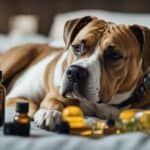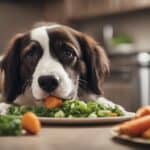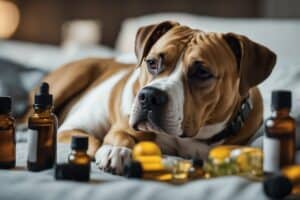Canine parvovirus, commonly known as parvo, is a serious viral disease that affects dogs, especially puppies.
It’s heartbreaking to see our furry friends go through the distressing symptoms of parvo, which can include severe vomiting, bloody diarrhea, and lethargy.
Any hint of this illness means a consult with a vet for a proper diagnosis and treatment plan.
However, there is an interest in home remedies and how they can support a treatment protocol, especially after the vet has assessed the situation.

While veterinary care is imperative, there are supportive measures that can help to manage the disease at home.
The importance of hydration and nutritional support at home while also understanding that these home-based approaches must complement, not replace, professional medical treatment.
And of course prevention is important too, and you should make sure your dogs have received their vaccinations as puppies and every 3 years thereafter to help ward off the virus.
When to Seek Veterinary Care
Before diving into the details, I want to stress that while home remedies can be a supportive measure in treating Parvo, there are critical situations where a vet’s care is absolutely necessary.
Recognizing these situations can make all the difference in your dog’s health and survival.
Understanding the Limitations of Home Remedies
When it comes to Parvo, home remedies, such as keeping them hydrated or providing a bland diet, can offer some support.
However, they are not cure-alls.
Parvovirus is a serious disease that can lead to rapid deterioration, so it’s crucial to understand that home care has its boundaries.
If a dog shows severe symptoms or isn’t improving with initial home care efforts, don’t hesitate to seek professional help.
- Severe Symptoms: Persistent vomiting, bloody diarrhea, extreme lethargy
- Not Responding to Home Care: No improvement within 24 hours
The Importance of Professional Diagnosis and Treatment
The moment you suspect Parvo, you need to see a veterinarian for a proper diagnosis.
Only a professional can confirm Parvo through specific tests, such as a stool sample analysis.
If diagnosed, treatment usually involves hospitalization, where intravenous fluids and injectable medications can be administered to tackle dehydration, secondary infections, and to provide essential nutrients.
Understanding Parvo in Dogs

Identifying Symptoms and Diagnosis
When it comes to parvo early recognition is important.
Symptoms of parvo include vomiting, diarrhea (often blood-stained feces), lethargy, fever, and a severe loss of appetite.
If you suspect your dog may have parvo based on these symptoms, a diagnosis is crucial.
Vets typically use a snap test to detect the virus quickly.
Stages of Canine Parvovirus Infection
The first stage is exposure to the virus, followed by an incubation period ranging from 3 to 7 days.
Active infection sees the symptoms mentioned above intensify, which requires immediate action to prevent dehydration and more severe complications.
Prevention and Vaccination
The most reliable method to protect dogs from parvo is through vaccination.
Puppies should receive their first parvo vaccine between 6 to 8 weeks of age, with boosters following every 3 to 4 weeks until they are 16 weeks old.
Its a good idea to keep puppies isolated from unknown dogs until fully vaccinated.
Home Treatment Strategies
When my own dog was diagnosed with parvo, I found that focusing on hydration and nutrition while exploring safe homeopathic remedies were incredibly beneficial.
Let me share some of the strategies I used to help my furry friend recover.

1. Hydration and Electrolyte Balance
Given that dehydration can be a critical concern with parvo, I ensured my dog always had access to fresh water.
To address the loss of electrolytes, I used a vet-recommended solution similar to Pedialyte to maintain proper electrolyte balance.
This supplemented fluids that were delivered subcutaneously by my vet, a technique that injected fluids directly under the skin, providing hydration over a longer period.
2. Dietary Adjustments and Nutritional Support
For nutritional support, I started with a fast to give my dog’s stomach a rest.
Then I introduced a bland diet consisting of easy-to-digest foods like boiled chicken and rice, gradually returning to a normal diet as her health improved.
Including bone broth not only helped with hydration but also provided nutrients to support her recovery.
3. Holistic and Homeopathic Approaches
Consulting with a holistic vet or homeopath was useful in choosing remedies that could complement traditional treatment.
As he got stronger, I used supplements and herbs known to boost the immune system, like Echinacea.
Caring for a Parvo-Infected Dog

When my dog was infected with Parvo, I learned the importance of a clean environment and strict isolation to manage the disease effectively.
Environmental Management
Parvo can survive on surfaces for months, making thorough cleaning and disinfection key to preventing the spread of the virus.
Here’s what I did:
- Bedding: I consistently washed my dog’s bedding in hot water and bleach.
It was important to remove any trace of the virus to prevent reinfection.
- Crates: I disinfected my dog’s crate daily using a solution of half a cup of bleach in one gallon of water, as it’s effective against Parvo.
Proper environmental management meant frequent and rigorous cleaning of any area my dog had access to, especially since Parvo can cause vomiting and diarrhea.
Isolation and Containment
Parvo is highly contagious, so isolation from other dogs was crucial.
I maintained a dedicated space for my sick dog, which was off-limits to other pets.
- Limiting Exposure: I kept my dog in a specific part of my home to contain the virus.
- Cleaning Routine: After handling my dog, I followed a strict hygiene protocol—washing hands thoroughly and using disinfectant on my clothing.
Minimizing my dog’s contact with others and being meticulous with cleaning and disinfection were my top priorities to optimize recovery and prevent spreading the virus.
e.
Monitoring and Managing Complications

Recognizing Secondary Infections
If my dog is battling Parvo, their immune system is compromised, making them more susceptible to secondary infections.
Keep a close eye on symptoms like unusual fatigue, worsening of diarrhea, or any sudden changes in behavior.
Signs of pneumonia or skin infections may also arise, which could require antibiotics to treat.
If I notice any such signs, don’t hesitate to contact my veterinarian immediately.
Observing for Dehydration and Nutrient Deficiency
Be especially watchful for signs of dehydration and nutrient deficiency since vomiting and diarrhea common in Parvo can quickly deplete a dog’s body of fluids and essential nutrients.
Here is how I monitor hydration:
- Gum Check: I gently press on my dog’s gums and see how quickly the color returns.
- Skin Elasticity: I gently pinch the skin between the shoulder blades and watch how fast it snaps back.
If a dog shows any of these signs, for example, if their gums stay white for more than a second or their skin doesn’t snap back immediately, these could be signs of severe dehydration and possibly require hospitalization for proper care and IV fluids.
To combat nutrient loss, easily digestible foods like chicken broth or rice water can be introduced slowly, but if there’s no improvement, consult my veterinarian as dehydration can be life-threatening.















